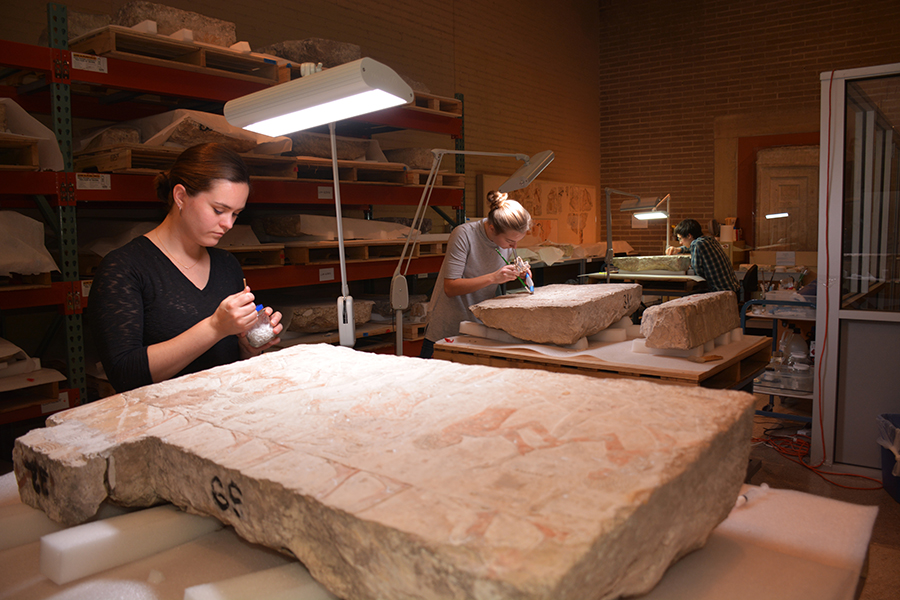https://www.penn.museum/sites/artifactlab/2018/03/06/a-typical-tuesday-in-kaipure/
On 03/06/18 06:00, mollygleeson wrote:
A typical Tuesday in Kaipure Anna O'Neill, Assistant Project Conservator
The Kaipure lab space in the Lower Egypt (Sphinx) Gallery lets visitors observe as conservators work on a tomb chapel wall, but we don't often have the opportunity to explain what's going on. So, here's a glimpse into what we might be doing on any given day.
9:00 am: We arrive in the conservation hallway, drop off our bags and grab a quick cup of tea to warm up before our weekly department meeting.
9:15 am: Department meeting! It's getting a bit crowded in here with so many conservators working on lots of different projects. We give our updates – "Still working on Kaipure" – and listen to everyone report their progress. Since we spend most of our time working in the Lower Egyptian Gallery, it's fun to hear all about all the various objects being treated.
10:00 am: Céline finished up the block she was working on yesterday, so our first order of business is to put her completed block back on the red shelves along the back wall and pull out a new pallet for her to work on.
10:15 am: We've completely rearranged the lab, clearing space in the middle and in front of the shelves so that we can bring in Big Joe, our forklift (no, really – his name is written on the side). Most of the time, people tend to think of conservation as a very delicate task, but we've had to become experts in heavy machinery, too.
10:30 am: We use Big Joe to move Céline's completed block to a shelf, measuring to make sure that it fits, and then raise the tines all the way up to the top shelf. It's the first time we've had to reach this high, so we've brought in Bob Thurlow, Special Projects Manager and resident forklift expert, to supervise while we bring down a new pallet. Fortunately, everything goes smoothly and we land the pallet on a wheeled table made specifically to hold the heavy weight of the blocks.

Left, Céline pulls a block from the top shelf – it's eight feet off the ground, but feels much higher! Right, Making sure the pallet is centered on the rolling table.
10:45 am: It's time to play Jenga with our workspace again as we put Big Joe back in storage and get our tables back in working position.
11:00 am: Céline begins documenting her new block, which means getting to know every inch of the object. She begins photography and condition mapping, while Jonathan and I get back to work on the pieces we already had out.
12:30 pm: Lunch time!
1:30 pm: We're back in the lab, each working on our blocks. Céline has finished documenting her new block, so she gets started on the first phase of cleaning – dusting with a soft brush and gentle vacuum.
Jonathan is busy with solvent cleaning, painstakingly rolling tiny cotton swabs saturated with acetone or ethanol over the surface to remove soiling, staining, and other substances that may have accumulated over the nearly 100 years the wall was on display.
I've done all the cleaning I can on my block and now I've moved on to stabilizing loose and lifted flakes of paint and stone. This is done by a process we call "edging", using a syringe to apply a mixture of Paraloid B72 bulked with glass microballoons and fumed silica to fragile areas, then gently shaping it with a solvent-soaked swab so they fill any gaps between flakes and the stone surface. These tiny fills serve multiple purposes: they fill empty spaces so they won't collapse under pressure; they protect the edges so the flakes won't be popped off if touched; and they provide light adhesion between the flake and the stone. Once inpainted, the B72/microballoon mixture blends right into the stone, but we feel much better knowing that the surface is more stable.
5:00 pm: The guards are making their rounds in the gallery to make sure all the visitors have left for the day. That means it's time for us to close up the Kaipure lab for the evening and head home.
All photos by Lucia Scanlan
The Kaipure Conservation Project is funded through a generous grant from the American Research Center in Egypt (ARCE) Antiquities Endowment Fund (AEF) which was established though a grant from the United States Agency for International Development (USAID).
-- Sent from my Linux system.




No comments:
Post a Comment